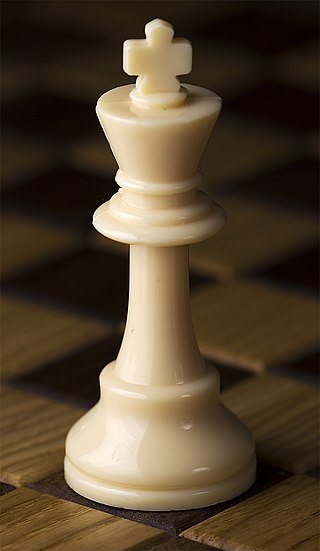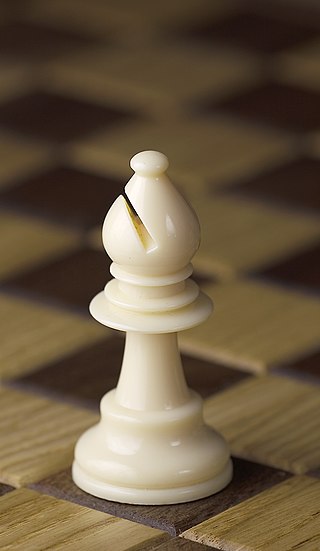Related Research Articles
Chess strategy is the aspect of chess play concerned with evaluation of chess positions and setting goals and long-term plans for future play. While evaluating a position strategically, a player must take into account such factors as the relative value of the pieces on the board, pawn structure, king safety, position of pieces, and control of key squares and groups of squares. Chess strategy is distinguished from chess tactics, which is the aspect of play concerned with the move-by-move setting up of threats and defenses. Some authors distinguish static strategic imbalances, which tend to persist for many moves, from dynamic imbalances, which are temporary. This distinction affects the immediacy with which a sought-after plan should take effect. Until players reach the skill level of "master", chess tactics tend to ultimately decide the outcomes of games more often than strategy. Many chess coaches thus emphasize the study of tactics as the most efficient way to improve one's results in serious chess play.

The king is the most important piece in the game of chess. It may move to any adjoining square; it may also perform a move known as castling. If a player's king is threatened with capture, it is said to be in check, and the player must remove the threat of capture on the next move. If this cannot be done, the king is said to be in checkmate, resulting in a loss for that player. A player cannot make any move that places their own king in check. Despite this, the king can become a strong offensive piece in the endgame or, rarely, the middlegame.

The bishop is a piece in the game of chess. It moves and captures along diagonals without jumping over intervening pieces. Each player begins the game with two bishops. One starts between the king's knight and the king, the other between the queen's knight and the queen. The starting squares are c1 and f1 for White's bishops, and c8 and f8 for Black's bishops.

The knight is a piece in the game of chess, represented by a horse's head and neck. It moves two squares vertically and one square horizontally, or two squares horizontally and one square vertically, jumping over other pieces. Each player starts the game with two knights on the b- and g-files, each located between a rook and a bishop.

Bughouse chess is a popular chess variant played on two chessboards by four players in teams of two. Normal chess rules apply, except that captured pieces on one board are passed on to the teammate on the other board, who then has the option of putting these pieces on their board.
In chess and other similar games, the endgame is the stage of the game when few pieces are left on the board.
This glossary of chess explains commonly used terms in chess, in alphabetical order. Some of these terms have their own pages, like fork and pin. For a list of unorthodox chess pieces, see Fairy chess piece; for a list of terms specific to chess problems, see Glossary of chess problems; for a list of named opening lines, see List of chess openings; for a list of chess-related games, see List of chess variants; for a list of terms general to board games, see Glossary of board games.
In chess, a tactic is a sequence of moves that each makes one or more immediate threats – a check, a material threat, a checkmating sequence threat, or the threat of another tactic – which culminates in the opponent's being unable to respond to all of the threats without making some kind of concession. Most often, the immediate benefit takes the form of a material advantage or mating attack; however, some tactics are used for defensive purposes and can salvage material that would otherwise be lost, or to induce stalemate in an otherwise lost position.
In chess, a relative value is a standard value conventionally assigned to each piece. Piece valuations have no role in the rules of chess but are useful as an aid to assessing a position.
In chess and similar games, check is a condition that occurs when a player's king is under threat of capture on the opponent's next turn. A king so threatened is said to be in check. A player must get out of check if possible by moving the king to an unattacked square, interposing a piece between the threatening piece and the king, or capturing the threatening piece. If the player cannot remove the check by any of these options, the game ends in checkmate and the player loses. Players cannot make any move that puts their own king in check.
In chess, a queen sacrifice is a move that sacrifices a queen in return for some compensation, such as a tactical or positional advantage.
In chess, a sacrifice is a move that gives up a piece with the objective of gaining tactical or positional compensation in other forms. A sacrifice could also be a deliberate exchange of a chess piece of higher value for an opponent's piece of lower value.
Yari shogi is a modern variant of shogi ; however, it is not Japanese. It was invented in 1981 by Christian Freeling of the Netherlands. This game accentuates shogi’s intrinsically forward range of direction by giving most of the pieces the ability to move any number of free squares orthogonally forward like a shogi lance. The opposite is true of promoted pieces which can move backward with the same power.
In chess, the exchange is a situation in which one player exchanges a minor piece for a rook. The side which wins the rook is said to have won the exchange, while the other player has lost the exchange, since the rook is usually more valuable. Alternatively, the side having a rook for a minor piece is said to be up the exchange, and the other player is down the exchange. The opposing captures often happen on consecutive moves, although this is not strictly necessary. It is generally detrimental to lose the exchange, although occasionally one may find reason to purposely do so; the result is an exchange sacrifice. The minor exchange is an uncommon term for the exchange of a bishop and knight.
In chess, a fortress is an endgame drawing technique in which the side behind in material sets up a zone of protection that the opponent cannot penetrate. This might involve keeping the enemy king out of one's position, or a zone the enemy cannot force one out of. An elementary fortress is a theoretically drawn position with reduced material in which a passive defense will maintain the draw.
In chess, a flight square or escape square is a safe square to which a piece, especially a king, can move if it is threatened.
A pawnless chess endgame is a chess endgame in which only a few pieces remain, and no pawns. The basic checkmates are types of pawnless endgames. Endgames without pawns do not occur very often in practice except for the basic checkmates of king and queen versus king, king and rook versus king, and queen versus rook. Other cases that occur occasionally are (1) a rook and minor piece versus a rook and (2) a rook versus a minor piece, especially if the minor piece is a bishop.
Shogi, like western chess, can be divided into the opening, middle game and endgame, each requiring a different strategy. The opening consists of arranging one's defenses and positioning for attack, the middle game consists of attempting to break through the opposing defenses while maintaining one's own, and the endgame starts when one side's defenses have been compromised.

The following outline is provided as an overview of and topical guide to chess:
Many basic tactics of shogi are similar to those of chess tactics, involving forks, pins, removing the defender and other techniques, all of which are considered very strong when used effectively.
References
- Hooper, David; Whyld, Kenneth (1996) [First pub. 1992]. The Oxford Companion to Chess (2nd ed.). Oxford University Press. ISBN 0-19-280049-3.